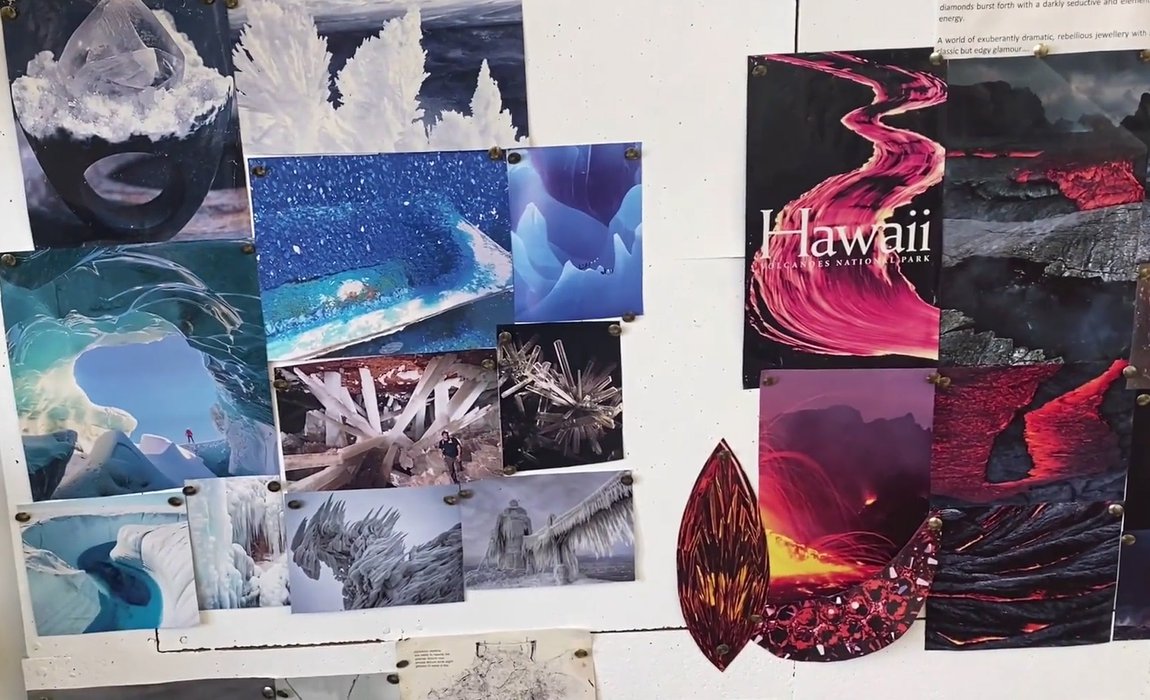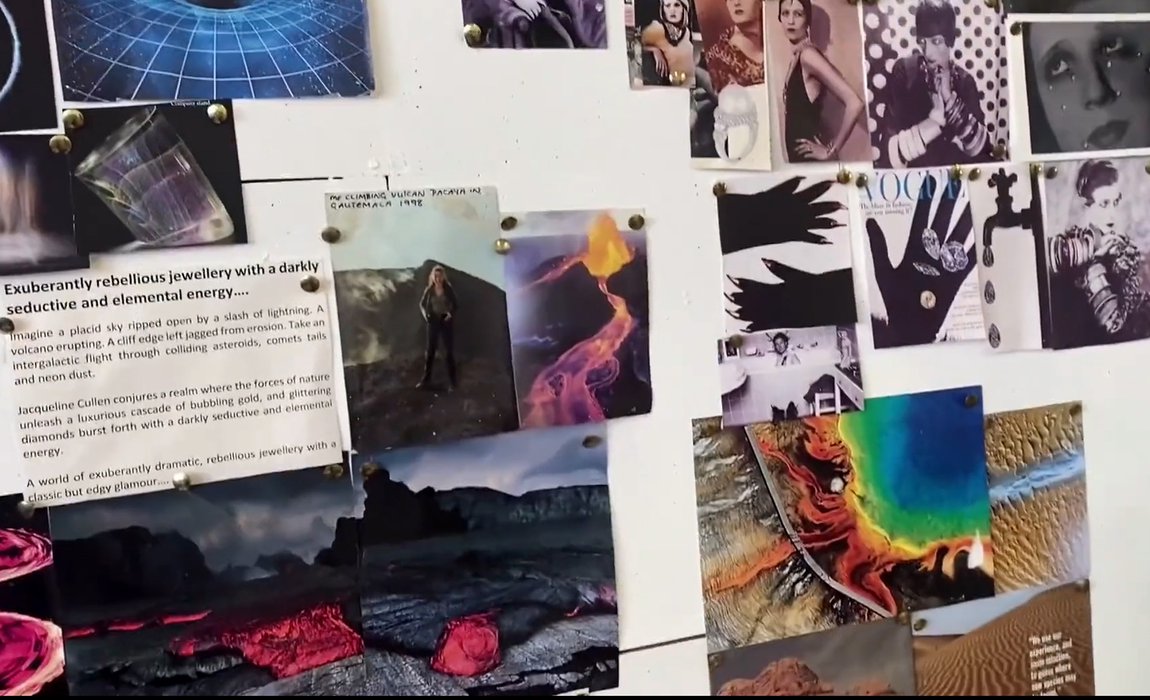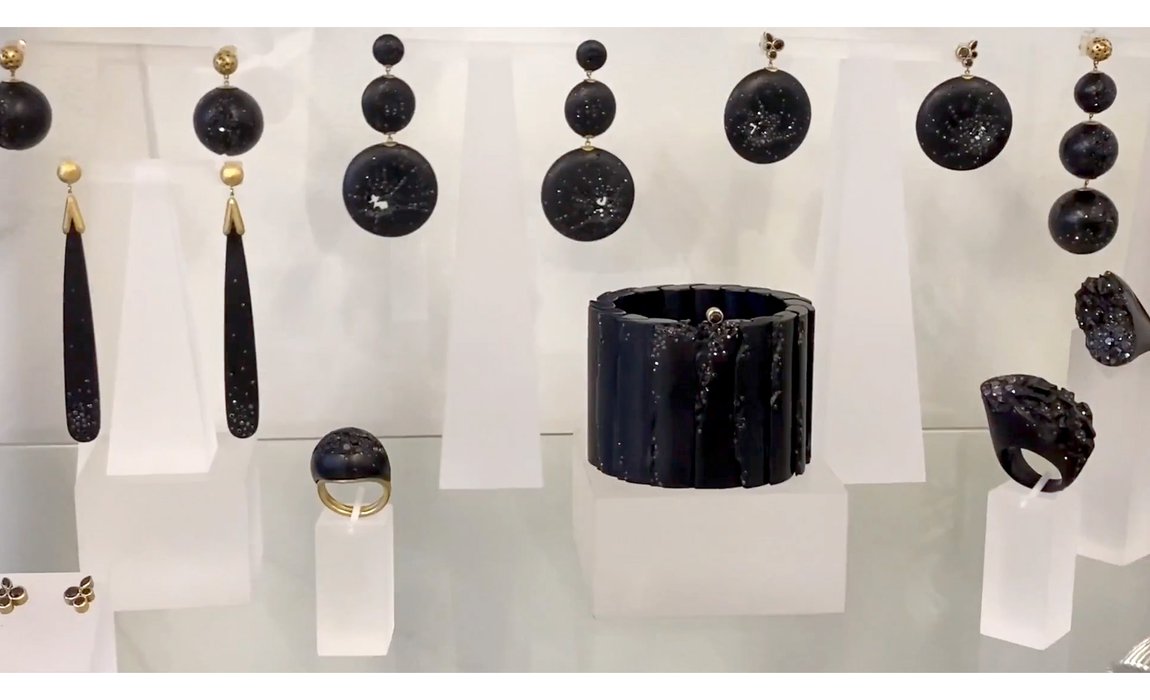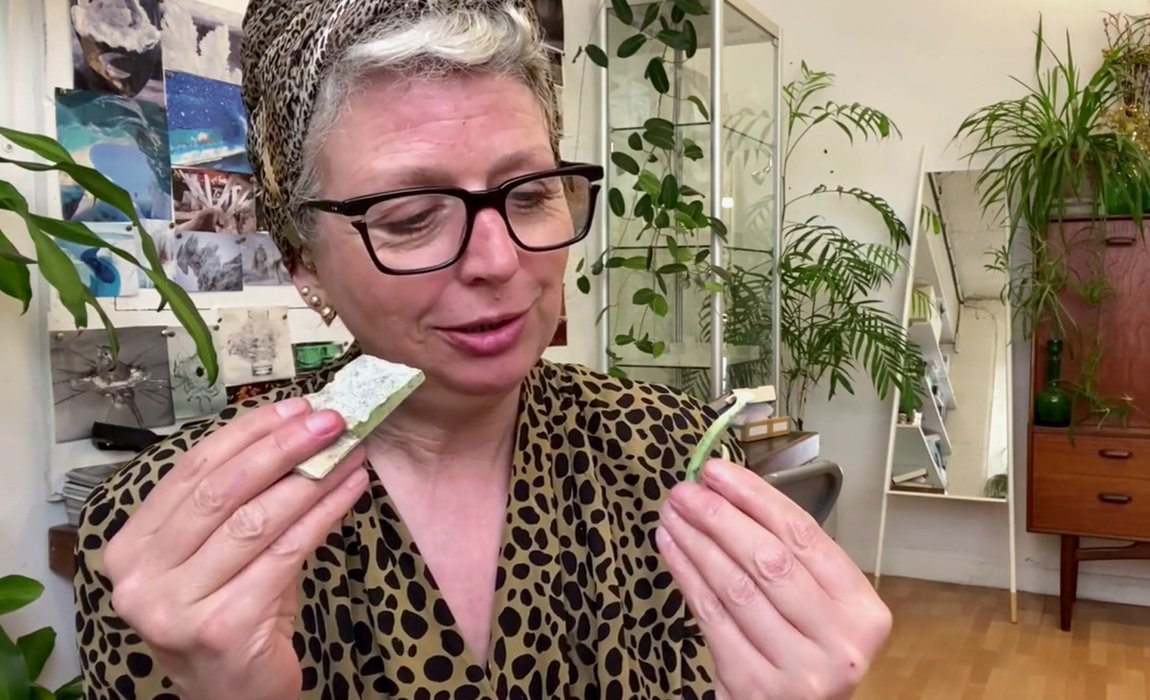Introducing Career Catalyst Grant 2020 Recipient Jacqueline Cullen
For eighteen years, jeweller and lapidarist Jacqueline Cullen has specialised in Whitby Jet, a rare stone hewn over millions of years from fossilised wood, and found in the rugged wilderness of Whitby, Yorkshire. The dramatic organic processes involved in the formation of Jet also informs the earthly themes of Cullen’s work, which is inspired by extreme natural phenomena such as volcanoes, black holes and earthquakes.
In 2020, Jacqueline’s proposal to expand her repertoire from Jet into hardstone earned her a Career Catalyst Grant from the Goldsmiths’ Centre - a flexible award of up to £5,000, aimed at fostering creative and career development in mid-career makers. Although aspects of Cullen’s project have been delayed due to the pandemic, she will soon journey to the home of lapidary specialists Mike and Sandra Walford in Whitby, where she will begin experimenting with hardstone under their expert guidance. We spoke to her about what we can expect from her long-anticipated project.
Introducing Jacqueline Cullen
How did you first become interested in Whitby Jet?
It sounds strange, but it was a eureka moment. I was in my second year of studying Jewellery Design at Central Saint Martins and I was sitting in my studio one day and all of a sudden it just came to me that I needed to work with Jet. I was very conceptual in my approach at that time, and whilst I was considering what to work with for my final year, I collected lots of samples of materials, and one of those materials was Jet.
Back then, I wasn’t really aware of its history. I had no idea where to get it or how to work it, but I was very interested in how rare it was and that no maker had really come along to take a contemporary approach to it. It was still very much a material associated with death and grief, and I loved the idea of challenging those common perceptions.
It transpired that the working processes involved in Jet were also very well suited to me. They are very sculptural and very instinctual. You’re working against grinding wheels and on lathes – very much feeling your way through the material and creating a shape by removing material. I also love the natural blackness of it. So that eureka moment turned out to be a very good idea, and since then I’ve specialised in Whitby Jet for 18 years. I can say with confidence that no other maker has taken Jet into the technical and aesthetic areas that I’ve taken it.
What have you learned from the process of undertaking your project so far?
Having specialised in Whitby Jet for 18 years, the Career Catalyst Grant is allowing me to train in lapidary, exploring all different types of hardstone. The techniques involved in working with Whitby Jet as opposed to hardstone are transferable to an extent - they’re broadly similar, but the details are very, very different.
My project has yet to officially start due to COVID-19, but what I have done so far is update a lot of existing equipment that I used exclusively for working with Jet - fittings and grinding wheels that would not have worked with hardstone. So, I’ve learned the different applications needed to work with hardstone, and I’ve also invested in other equipment and tools, for carving. Finally, I’ve collected a lot of samples in order to create a catalogue of all the different types of stone and their technical properties. When I do start making pieces, I can show my clients samples of different stone combinations, so that they can select which colours or stone types they think work together, and then I can go on and make the piece.
What I’m learning at the moment is what’s different about working with stone compared to Jet on a basic level, in addition to what a typical lapidary workshop would have at their disposal, regardless of their specialisation, and all the different attachments that you use for carving stone and finishing. I'm also learning about the different polishing processes and which compounds are used for which stone.


You mentioned that Whitby Jet is often associated with death - why is that the case?
Whitby Jet can only be found in Whitby in the UK, which is where Dracula’s boat famously landed. It’s a very Gothic sort of place. It’s also the material’s natural blackness. When Queen Victoria’s husband Prince Albert died, the Queen started to wear Jet jewellery, and that created a big fashion trend that lasted about 80 years.
At that time, there were very strict rules about grieving, particularly for women - what they could wear and for how long. If you think about black dresses from that era, they had a lot of ornate details, and Jet is black and naturally light-weight - so it can be used to make quite large pieces that would stand out on clothing. It’s also very easy to carve, so the cameos and intaglios and lettering that people were carving at that time, wreaths and clasped hands and so on, Jet was perfect for that.
As fashions changed and Art Nouveau and Art Deco became more popular, it fell out of favour. People almost developed an aversion towards it because it was associated with this period of Victorian mourning jewellery, and no-one ever thought about liberating the material from that pigeon hole.
Is Whitby Jet a finite resource because it can only be found in one place?
It is a lot rarer than it used to be. If someone who was reading this decided to go out tomorrow and source some Jet, they’d find it incredibly difficult. Jet is found in the cliffs, some of it is in the sea, but Jet washing up on the beach isn’t really something that happens anymore - not in any significant size or quantity. The area is very typically Wuthering Heights - wild moors and jagged cliffs with crashing waves, so it’s all quite dramatic.
My supplier lives in Whitby and I’ve worked with him for I think 16 years. It was another intuitive moment when I connected with him. He’s an abseiler and goes over the cliffs on a rope, and gets into ancient caves and Victorian crawl holes to collect raw Jet, which I then buy from him. It was first mined in Victorian times and when I say mined, I don’t mean in the traditional sense - it was individuals hacking out little tunnels into the side of the cliffs with pickaxes and other tools. It was very much a small-scale, local industry.

Can you tell us what you’re working on at the moment?
We are hoping to have our in-person Open Studio at Cockpit Arts at the end of June, which we haven’t had for a year and a half. I’ll also be exhibiting at Goldsmiths’ Fair, which I think is my 14th time showing there, and I’m really hoping that it will be in person.
We’re planning to start the training for the Career Catalyst Grant in July. First of all, in Jet for the Open Studios, I’m revisiting a technique that I previously used in 2013 called electroforming, and creating a new collection using that technique, which will be inspired by lava and volcanic eruptions. Then I’ll be using stone to create a number of basic samples, using shapes that I already know how to make in Jet, and selling the results.
I will be specifically making earrings and rings, using shapes that will allow me to practice working in different types of hardstone. Those pieces will be sold at a very reduced price because they will basically be the results of me practicing with hardstone. I’ll also be trying out an idea that I mentioned already - using my box of samples of stones. I might make a pair of earrings in two different stones, one stone for the top part and a different stone for the hanging bottom part. A customer can then come in and say, actually I’d prefer lapis lazuli at the top, and with green Jade at the bottom, for example. I can then create that piece as a commission. So, I’ll be offering an element of customisation which will also provide an opportunity for me to start practicing on a very basic level - finding out how a shape might be easy to work in one particular stone but a nightmare in another.
Will Jet continue to be a focal point of your work going forward?
I will continue working with Jet. The reasons for this project are because, I’ve specialised only in Jet for 18 years, except for in 2017, when I started to feel very limited by only working in one material. I wanted to start saying to myself, this is my concept for a piece or a collection, what can I make it in? Rather than, this is my concept - how do I make it in Jet?
In 2017, I created a collection with my mentors in Whitby in grey agate with champagne and blue diamonds, and launched it at Goldsmiths’ Fair. The response was surprise and amazement that I’d done something so different. That gave me the thirst to explore the option of other materials, but I still wanted to stay within my brand identity of lapidary, which is a very sculptural process with lateral materials.
I also have an overall design project called Elementa, which encompasses four themes; galactica tundra, lava and terra. These four sections are all related to elemental and primordial energy, like volcanoes erupting, black holes, and colliding dark matter. I'm now looking at which stones will be appropriate for which theme.

Does the Career Catalyst Grant give you freedom to experiment in a way you might otherwise be unable to?
Absolutely, because what the Grant will provide me with is technical knowledge. I have a lot of technical knowledge with Jet, but I don’t have it with stone. When I say stone, I obviously mean a lot of different materials that fall within that umbrella. Each stone is actually a very individual material that requires different ways of working.
Mike and Sandra Walford, who are based in Whitby, have helped me with production in general. They are one of the few production lapidary unit’s in the UK, and between them they have 85 years of lapidary and stone cutting experience, so their knowledge of stone, rock and fossils is huge - they are obsessed with it. The grant will allow me to go to Whitby five times, for a week each time, to work with them.
The training they’re offering is bespoke, completely tailored to me, and it’s about exploring lots of different stones, processes and equipment to see what really works for me, whether that’s lapiz, moonstones, rock crystal, etcetera. It’s going to open up a whole new world for me, aesthetically and creatively, as well as technically - providing it starts when it’s supposed to!
Which expected or unexpected things have happened as a result of the project?
Well, the fact of not being able to start! As is the case for a lot of creative people, it’s been a very challenging time. Back in March 2020, all shows suddenly shut down and all the work disappeared. So when I got an email from the Goldsmiths’ Centre saying that I was going to be a recipient of the Grant, it gave me such a lift. Sitting here a year later, I can’t claim that I’d ever have imagined that I still wouldn’t have been able to start. But what it gave me at the time, and what it has given me since, is the knowledge that at some point in the future, I have something waiting that will rejuvenate me creatively, and give me something new to get my teeth into - as far as exploring new technical processes and materials. So even now, I’m still sitting here, knowing that in the near future, my creative world is going to really open up.


What is it like working with experts in your field as mentors?
I have worked with Mike and Sandra since 2013. And I already knew of them and had met them a couple of times before that.
When I first started working with them, I was doing a lot of wholesale work in the US and high-end trade shows over there. I was selling with companies like Net-a-Porter – I was creating a lot of volume and very much focused on small batch production. I started working with them because everything had been in-house previously and it got too much. Now my own work has gone in an entirely different direction, much more into the area of small, bespoke projects rather than wholesale and aimed at the US market.
Mike and Sandra’s knowledge surpasses everything. They’re a married couple, and they are very sweet, very helpful, and very supportive. They’re unusual people - they don’t even own a laptop. They have the technical knowledge and I have my creative ideas and we’ve managed to meet in the middle. I trust them completely and I’m really looking forward to working with them fully on this.
So, what are your next steps?
To start the Grant! As I said, I’m hopefully starting the training in July, which means going up to Whitby for a week, followed by another week in August and then in September. Initially I’ll be doing samples and very basic things, trying my hand at creating simple shapes for the Open Studios, and hopefully, developing a small body of work in time for Goldsmiths’ Fair. Although I’m working towards an overall design project, what I’m trying to do is keep an open mind, to explore the different stones and different techniques without a particular agenda. I don’t want to begin this project thinking that I want to do inlay or lamination or mosaic work - I just want a very loose, general idea of what I want to explore. I feel that I owe myself the opportunity to really immerse myself in something creative, for creativity’s sake.
Obviously, I'm going to learn a lot of things on a technical level, but I want to let the outcome arrive naturally rather than start the training with a specific outcome in mind for a body of work. After a year and a half of enforced inactivity, a period of just being able to play, be creative and explore new things is a gift, and I’m excited to see what that does for my work.
Jacqueline Cullen - First Update - Career Catalyst Grants 2020